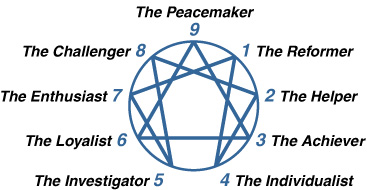
Want to discover how your personality type can help you become your best self? Then it’s time to learn more about Enneagrams!
—
For centuries, people have turned to mystical methods and divinations in their path to self-discovery. From astrology to numerology, humans have been seeking ways to help them better understand themselves and the world. A recent trend in self-discovery is the Enneagram of Personality.
The Enneagram is a test-based methodology involving a balance of points within a geometric shape. Inside the shape are intersecting lines that create nine equidistant points on the perimeter of the circle. These points represent the nine different personality types that can be used to boost your mood, plan your day, and even find a soulmate.
Although it is possible to possess multiple types of personalities, the main traits and characteristics that will guide you towards your best self are found in your dominant personality type which determines how you are with other people and how you interact with yourself.
There are two parts to the dominant personality: the Grower and the Stressor.
The Grower is the part of you that challenges and supports yourself. The Stressor is the part that limits and restricts you. The Enneagram model is designed to help you move towards your Grower and away from your Stressor.
Each of the nine Enneagram personality types also has a corresponding flower associated with it. Once you have identified your personality type, you can use your flower type to spread positivity and happiness in your life and around your home.
To find out which personality type you are, take this test: Enneagram of Personality. Use what you learn to dive deep into yourself in order to grow into the best self that you are meant to be.
The 9 Personality Types:

1. The Reformer
The Reformer is the first personality type of the Enneagram. If you are a reformer, you might be a perfectionist, as they are known to be principled, purposeful and have great self-control. A Reformer who has found their best self is typically wise and discerning. They are motivated by their fear of becoming corrupt and often look to be right by setting high goals.
The flower associated with Reformers are asters, which represent wisdom and devotion.
2. The Helper
Helpers are generous, people-pleasing, and possessive. They are empathetic people who mean well and many times do things solely for the benefit of other people. Helpers desire to be loved and fear being thought of as selfish. If you are a helper, you can grow and find your best self by learning to take care of yourself before you love others.
Helpers should plant sunflowers which can grow taller than people and are a beautiful sight that symbolizes a loyal and selfless spirit.
3. The Achiever
If you are an Achiever then you are probably adaptable, ambitious, energetic, and image conscious. Since you thrive on the attention of others and have a fear of being worthless, an Achiever has the ability to be a role model and inspire others. To find your best self, make sure to be honest with those around you, as this will help you earn their respect.
Tulips are a great flower for Achievers because they represent beauty and confidence.
4. The Individualist
Individualists are often expressive, dramatic, and self-absorbed. If you are an individualist, you can be creative and know how to transform an experience. You can also be moody and temperamental at times, but that is because you fear losing identity. To find your best self, an individualist shouldn’t let your mood dictate your experiences.
Hydrangeas are matched with Individualists because they represent understanding and emotion.
5. The Investigator
The Investigator is someone who is typically perceptive, secretive, and isolated. Investigators often get caught up in their thoughts and can be a little intense, but they are also very innovative. If you are an investigator, you can find your best self by keeping in touch with people to avoid the fear of being useless or incompetent.
Investigators are daydreamers, so their flower is the peony, which represents romance and prosperity. Put this flower in your home to spice things up or find a new path.
6. The Loyalist
Loyalists are engaging and responsible people who tend to be self-reliant. They can also be very anxious and suspicious at times due to their desire to feel secure and supported. When they feel like they lack guidance in their lives they tend to have challenges. Loyalists can find their best self by using their anxiety as a catalyst for new ideas and hobbies.
Loyalists are often cautious and indecisive, so their flower is a daisy which represents innocence and purity.
7. The Enthusiast
Enthusiasts are versatile, spontaneous, and easily distractible because they are high-spirited and playful. Their focus is on being happy and appreciated so they can sometimes seem childlike. If you are an Enthusiast, you can find your best self by learning to recognize your impulses without giving into them. This will help you build self-control and stability.
Enthusiasts have a flower that represents beauty, innocence and admiration of life: orchids. Just like Enthusiasts, orchids bring happiness to any room they enter.
8. The Challenger
Challengers are confident, decisive, and confrontational. They are not afraid to speak their minds and tend to be straightforward and can even be inspiring with their powerful manners. If you are a Challenger, find your best self by motivating others to use their strengths rather than dominating them with yours.
The gladiolus flower is perfect for Challengers because it represents strength, integrity and confidence.
9. The Peacemaker
Peacemakers are receptive, agreeable, and reassuring. In order to keep the peace, they will often not speak up, even if they know they should. They also use their fear of losing loved ones as an incentive to keep things in order. If you are a Peacekeeper, the way to develop your best self is to work on satisfying your own needs.
A Peacekeeper’s flower is the lilac, which represents tranquility and relaxation.
You may also enjoy reading Millenneagram: A Badass Twist on an Ancient Tool of Self Discovery by Hannah Paasch